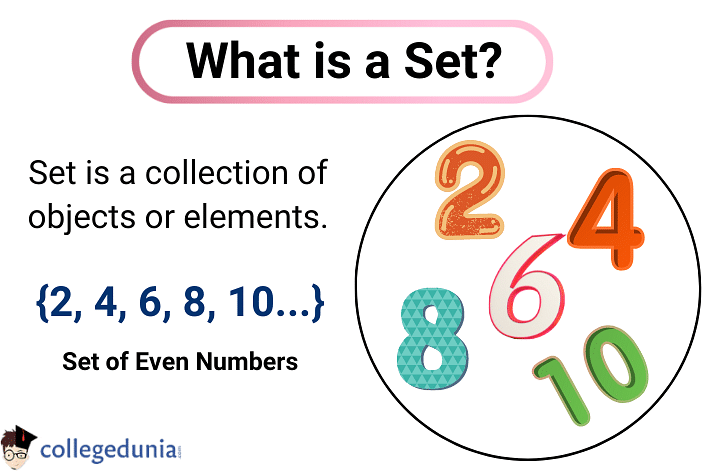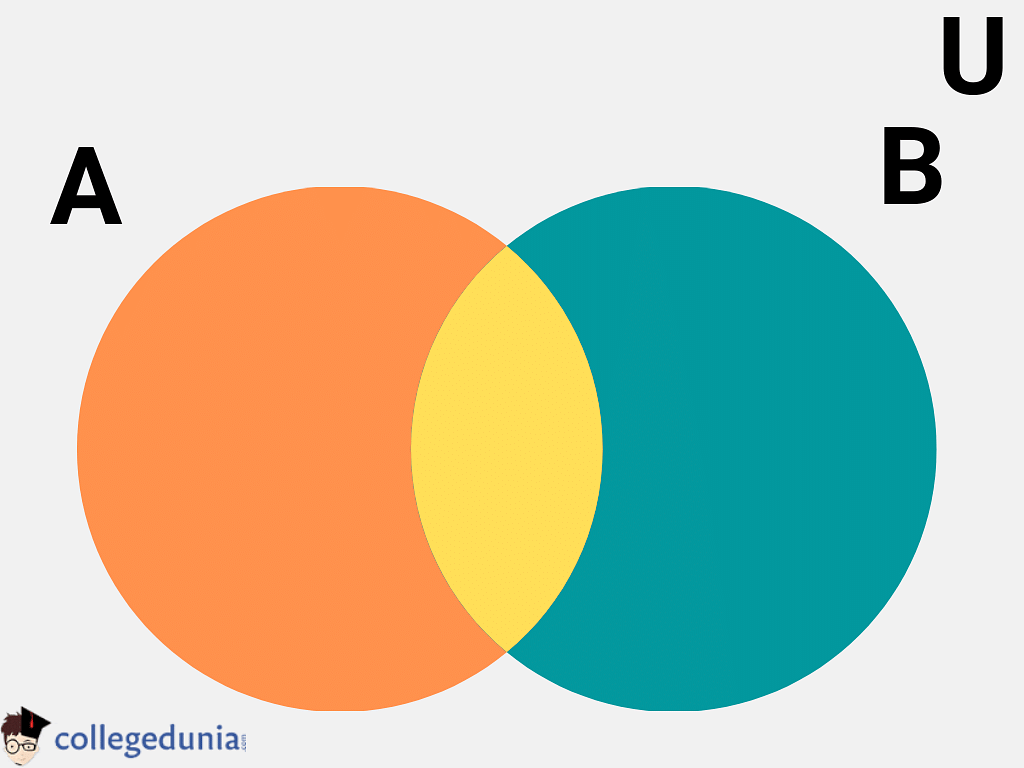
Muskan Shafi Education Content Expert
Education Content Expert | Updated On - Jul 25, 2025
Sets are well-defined and organized collections of elements and objects in Mathematics. Set Theory is a branch of Mathematics dealing with the study of sets, their properties, symbols, and operations. Set Theory was developed and proposed by Georg Cantor, a German mathematician.

- Sets are organized collections of objects whose elements are fixed and cannot be changed.
- The objects or items present in a set are known as their elements.
- The elements of a set can be any number, alphabetical letters, numbers, symbols, etc.
- A set is denoted by a capital letter and its elements are listed within curly brackets as A = {1, 2, 3, 4, 5}.
- Sets are represented in three different forms namely, Set-builder Form, Roster Form, and Statement Form.
- Set Operations are mathematical operations performed on sets and their types.
- Union of Sets, Intersection of Sets, Difference of Sets, and Complement of a Set are the four main set operations.
Related Links
- Appearing for JEE Main, Download JEE Mains PYQ for all sabjects
- Appearing for CUET, Download CUET PYQ for all subjects

What is a Set?
Read More: NCERT Solutions for Class 11 Maths Sets
Very Short Answer Questions (1 Mark Questions)
Ques. State the various types of Sets.
Ans. The various types of Sets are:
- Singleton Set
- Finite Set
- Infinite Set
- Null/Empty Set
- Equal Sets
- Unequal Sets
- Disjoint Sets
- Superset and Subset
- Universal Set
Ques. Represent the set Y = {x : x is an integer, –1 x < 5} in roster form.
Ans. The set Y = {x : x is an integer, –1 x < 5} will be expressed as Y = {–1, 0, 1, 2, 3, 4} in Roster Form.
Ques. From the sets given, what is the pair of equivalent sets?
- A = {1, 2, 3}
- B = {x, y, z, t}
- C = {a, b, c}
- D = {0, a}
Ans. A = {1, 2, 3} and C = {a, b, c} are equivalent sets.
Ques. Demonstrate the positive prime numbers that are less than two in form of a set.
Ans. The number 2 is the smallest positive prime number, and 1 is not a prime number. Thus, the set of positive prime numbers that are less than two is an empty or null set. It is expressed as P = { } or Φ.
Ques. If A = {2, 4, 8} and B = { 8, 4, 2}, what kind of sets are these?
Ans. Set A and Set B are equal to each other since both sets have the same elements. Therefore, it can be said that the elements of set A are equivalent to the elements of set B. Hence, A and B can be called equal sets.
Ques. What all elements can be included in Sets?
Ans. The elements of any set can be natural numbers, rational numbers, whole numbers, imaginary numbers, or complex numbers.
Set Detailed Video Explanation
Ques. What is a Universal Set?
Ans. A universal set is defined as a collection of all the elements of a particular subject. Universal Set is denoted by 'U'. For instance, set U = {List of Integers}. In this set, a set of natural numbers, even and odd numbers are all subsets of this universal set.
Ques. What are the main Set Operations?
Ans. The main set operations are as follows:
- Union of Sets (∪)
- Intersection of Sets (∩)
- Difference of Sets (–)
- Complement of a Set (A′ or Ac)
Ques. What is Union of Sets?
Ans. Union of sets is a set operation that lists the elements in set A and set B or the elements in both set A and set B. It is denoted by the symbol “A U B”.
For example, {3,5} ∪ {1, 5} = {1, 3, 5}
Read More:
Short Answer Questions (2 Marks Questions)
Ques. Represent the given sets in Roster Form.
(i) U = {x : x is an integer and – 3 ≤ x < 7}
(ii) B = {x : x is a Natural Number which is less than 6}
Ans. (i) Given that, A = {x : x is an integer and –3 ≤ x < 7}
According to the condition, the integers will be -5, -4, -3, -2, -2, 0, 1, 2, 3, 4, 5, 6, 7, 8,…..
Thus, A = {-3, -2, -1, 0, 1, 2, 3, 4, 5, 6}
(ii) Given that, B = {x : x is a Natural Number less than 6}
The natural numbers are 1, 2, 3, 4, 5, 6, 7, 8, ……
Thus, B = {1, 2, 3, 4, 5}
Ques. Represent the Venn Diagram for (A ∩ B)’.
Ans. The Venn Diagram for (A ∩ B)’ is as follows:

Ques. Are the following pair of sets equal?
- A = {x:x is a letter in the word SORROW}
- B = {y:y is a letter in the word SOW}
Ans. Elements of Sets are:
- A= {S, O, W}
- B = {S, O, W}
Hence, A = B.
Ques. If A = {3, 5, 7, 9, 10}, B = {7, 9, 10, 13}, and C = {10, 13, 15}. Find (A ∩ B) ∩ ( B ∪ C).
Ans. Given sets are:
- A = {3, 5, 7, 9, 10}
- B = {7, 9, 10, 13}
- C = {10, 13, 15}
A ∩ B = {7, 9, 10}
B ∪ C = {7, 9, 10, 13, 15}
(A ∩ B) ∩ (B ∪ C) = {7, 9, 10}
Ques. Given, X = {a, b, c, d} and Y = {f, b, d, g}, determine the final value of X – Y and Y – X.
Ans. Given Sets are:
- X = {a, b, c, d}
- Y = {f, b, d, g}
X – Y = {a, b, c, d} – {f, b, d, g} = {a, c}
Y – X = {f, b, d, g} – {a, b, c, d} = {f, g}
Ques. Represent the given sets in the Roster Form.
(i) A = {x | x is a positive integer which is less than 10 and 2x – 1 is an odd number}
(ii) B = {x : x2 + 7x – 8 = 0, x ∈ R}
Ans. (i) Since 2x is an even number, 2x – 1 is an odd number for all positive integral values of x.
In simpler terms, 2x – 1 is an odd number for x = 1, 2, … , 9.
Thus, A = {1, 2, 3, 4, 5, 6, 7, 8, 9}
(ii) x2 + 7x – 8 = 0
On simplification,
(x + 8) (x – 1) = 0
x = – 8 or x = 1
Thus, B = {– 8, 1}
Read More: Sets Important Questions
Ques. Given sets are A = {a, b}, and B = {a, b, c}. Is A ⊂ B? Find A ∪ B.
Ans. Given sets are
- B = {a, b, c}
- A = {a, b}
Yes, A ⊂ B, Therefore, the union of the set's pairings can be expressed as
A∪ B = {a, b, c} = B
Ques. If U = {x : x ∈ N, x ≤ 9}, A = {x : x is an even number, 0 < x < 10}, and B = {2, 3, 5, 7}, what will be the Set (A U B)?
Ans. It is given that,
- U = {x : x ∈ N, x ≤ 9}
- A = {x : x is an even number, 0 < x < 10}
- B = {2, 3, 5, 7}
Thus, in roster form, the sets will be
- U = {1, 2, 3, 4, 5, 6, 7, 8, 9}
- A = {2, 4, 6, 8}
A U B = {2, 3, 4, 5, 6, 7, 8}
(A U B)’ = {1, 9}
Check More:
Long Answer Questions (3 Marks Questions)
Ques. Set S = {5, 10, 15, 20, 25, 30} is given in the roster form. Rewrite it in,
(i) Set Builder Form
(ii) Semantic Form
Ans. The given set is S = {5, 10, 15, 20, 25, 30}.
(i) In set-builder notation, it will be written as S = {x : x is a multiple of 5 and 1 < x < 35, x ∈ N}.
(ii) in semantic form, it will be written as S = {Multiples of 5 less than 35 and greater than 0}.
Ques. Let A and B be two sets containing 3 and 5 elements respectively. What is the maximum and the minimum number of elements in A ∪ B?
Ans. There can be 3 elements that are common, at least, between both the given sets.
Let
- A = {a, b, c}
- B = {a, b, c, d, e}
Therefore, A ∪ B = {a, b, c, d, e,} implies that the minimum number of elements in A ∪ B are 6.
It can also be that, there are no elements that are common between both sets.
For example,
- A = {a, b, c}
- B = {d, e, g, h, i}
Thus, A ∪ B = {a, b, c, d, e, g, h, i}. It implies that the maximum number of elements in A ∪ B is 8.
Ques. If ∪ = {a, e, i, o, u} and
- A = {a, e, i}
- B = {e, o, u}
- C = {a, i, u}
Verify whether the value is true or not: A ∩ (B - C) = (A ∩ B) - (A ∩ C).
Ans. According to the sets given,
- B – C = {e, o}
- A ∩ (B - C) = e
- A ∩ B = {e}
- A ∩ C = {a}
(A ∩ B) - (A ∩ C) = e
Now, A ∩ (B - C) = e and (A ∩ B) - (A ∩ C) = e.
Thus, A ∩ (B - C) = (A ∩ B) - (A ∩ C)
Hence Proved.
Ques. According to a survey, 73% of Kashmiris actually like apples, while around 65% of them like oranges. Determine the percentage of Kashmiris who like both apples and oranges.
Ans. Let us assume that,
- A = Set of Kashmiris who like Apples
- B = Set of Kashmiris who like Oranges
Thus,
- n (A) = 73
- n (B) = 65
n (A∪B) = 100
n(A∩B) = n(A) + n(B) - n(A∪B)
= 73 + 65 – 100
= 38
Thus, about 38% of the Kashmiris like both apples and oranges.
Ques. In a college, 20 professors teach mathematics or physics. If 12 teach maths and 4 teach both physics and maths, How many teach Physics?
Ans. Given that,
- Total Teachers n(M∪P) = 20
- Teachers teaching Maths n(M) = 12
- Teachers teaching both Maths and Physics n(M∩P) = 4
- Teachers teaching Physics n(P) =?
Thus,
n(M∪P) = n(M) + n(P) - n(M∩P)
n(P) =12
Thus, there are 12 teachers teaching Physics.
Very Long Answer Questions (5 Marks Questions)
Ques. There are 100 students in a Student Activity Club of which 35 like drawing and 45 like music. 10 students are interested in both drawing and music. Find the number of students that like either of them or neither of them.
Ans. Given that,
- Total Number of Students = 100
- Number of Students liking Painting, n(P) = 35
- Number of Students liking Dancing, n(D) = 45
- Number of Students liking Both Painting and Dancing, n(P∩D) = 10
The number of students who like either of them (n(P ∪ D)) and the number of students who like neither (n(P∪D)) needs to be calculated.
Using Sets Formula,
n(P∪D) = n(P) + n(D) – n(P∩D)
45 + 35 - 10 = 70
Therefore, there are 70 students who like either music or drawing.
Number of Students Who like Neither Painting or Dancing = Total Students – n(P∪D) = 100 – 70 = 30
Therefore, there are 30 students who like neither music nor drawing.
Ques. Let set A = {1, 2, 3, 4, 5, 6, 7, 8}, and set B = {3, 5, 7, 9, 11, 13}. Find:
(i) A U B
(ii) A ∩ B
(iii) (A ∩ B)’
Ans. Given sets are:
- A = {1, 2, 3, 4, 5, 6, 7, 8}
- B = {3, 5, 7, 9, 11, 13}
(i) A U B
Union of sets is the unique elements of both sets as a whole without being repeated. Thus,
A U B = {1, 2, 3, 4, 5, 6, 7, 8, 9, 11, 13}
(ii) A ∩ B
Inverted U means an intersection that finds elements common to both sets.
A ∩ B = {3, 5, 7}
(iii) (A ∩ B)’
It is a complement of the set operation. Thus,
(A ∩ B)’ = {1, 2, 4, 6, 8, 9, 11, 13}
Ques. There are 200 individuals with a dermatological disorder. 120 were exposed to the chemical C1, 50 to chemical C2, and 30 to both the chemicals C1 and C2. What is the number of individuals exposed to
(i) Chemical C1 but not chemical C2?
(ii) Chemical C2 but not chemical C1?
(iii) Chemical C1 or chemical C2?
Ans. Set A signifies the set of individuals exposed to the chemical C1, while B denotes the set of individuals exposed to the chemical C2.
- n (U) = 200
- n (A) = 120
- n (B) = 50
- n (A∩B) = 30
Thus,
(i) n(A-B) = n(A) - n(A∩B) = 120-30 = 90
(ii) n(B-A) = n(B) - n(A∩B) = 50 - 30 = 20
(iii) n(A∪B) =n(A)+ n(B)- n(A∩B) = 120 + 50 - 30 = 140
Ques. In a Sports Academy, there are players that play either Baseball or Football or both. The number of players who play Baseball or Football or both is 11, 12 and 3 respectively. What will be the number of students playing either cricket or badminton?
Ans. Consider that,
- n(Baseball) = n(P)
- n(Football) = n(Q)
- n(Either Baseball or Football) = n(P∪Q)
- n(Baseball and Football) = n(P∩Q)
Given that,
- n(P) = 12
- n(Q) = 12
- (P∩Q) = 3
Using the Sets Formula,
n(P∪Q) = n(P) + n(Q) - n(P∩Q) = 11 + 12 - 3 = 20
Thus, there are 20 players that are playing either cricket or badminton.
Join Our Telegram Channel for Live Updates on Board Exams: https://t.me/class_10_12_board_updates
Check-Out:





Comments